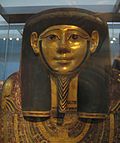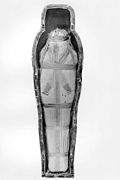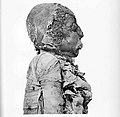| Image | Name | Role | Year of Death | Dynasty | Gender | Year discovered | Short summary |
|---|
| — | Ankh-hap | Unknown | Unknown | Ptolemaic | Male | Unknown | The mummy and coffin of Ankh-hap are housed in the Houston Museum of Natural Science, on permanent loan from the Texas A&M University. His body is much fragmented and has been reinforced with wooden sticks. [1] |
 | Antjau | Unknown | 0664 664-660 BC | 26th | Male | Unknown | Displayed in the Royal Ontario Museum. [2] |
 | Asru | Temple singer | 0700 700 BC | 25th | Female | 1825 1825 | The unwrapped body of Asru was donated to Manchester Museum in 1825 along with her two coffins. She was likely from Thebes (modern Luxor). She was 50–60 years old at death; testing has revealed she suffered from several types of internal parasites. [3] |
| — | Djed-Amunet-ius-ankh | Lady of the estate | Unknown | 22nd/23rd | Female | mid-19th century | Djed-Amunet-ius-ankh is estimated to have died at around the age of between 19 and 20. Her death was likely due to complications during childbirth. The mummy is on permanent display at the museum in Racibórz. [4] |
 | Djedmaatesankh | Temple singer | Unknown | 22nd | Female | Unknown | Djedmaatesankh was 30–35 years old when she died, possibly from sepsis caused by a dental abscess. Her mummy is on display in the Royal Ontario Museum. [5] [6] |
 | Djedptahiufankh | Second Prophet of Amun | 0935c. 935 BC | 22nd | Male | 0019 19th Century | |
 | Djehutynakht | Nomarch | Unknown | 11th/12th | Male | 1915 1915 | |
| — | Hekashepes | Noble | Unknown | 6th | Male | 2023 2023 | In 2023 Hekashepes's intact burial was discovered at Saqqara. His stone sarcophagus was found at the bottom of a shaft at Gisr el-Mudir, near the Step Pyramid. His body appeared to be wearing clothes and jewellery including a collar and belt, and is decorated with gold. [7] [8] [9] |
| — | Henut Taui | Priestess | Unknown | 21st | Female | Unknown | |
| — | Henut-wedjebu | Priestess | 1300 BC c. 1300 BC | 18th | Female | 1896 1896 | Henut-wedjebu was a chantress of Amun who lived during the Eighteenth Dynasty c. 1300 BC. Her tomb intact tomb was discovered in 1896 at Sheikh Abd el-Qurna, Luxor. Her coffin and mummy were gifted to Washington University in St. Louis and are permanently displayed in the Saint Louis Art Museum. Henut-wedjebu's mummy has never been unwrapped but CT scans revealed her organs were not removed during mummification. She may have died of an infection as she has calcifications in her lymph nodes and scarring in her lungs. [10] [11] [12] |
 | Hornedjitef | Priest | 0220 c. 220 BC | Ptolemaic | Male | Unknown | Hornedjitef was a priest of the temple of Amun at Karnak during the reign of Ptolemy III. His coffins and cartonnage-covered mummy were discovered in Asasif in Thebes, modern Luxor. He was 55–65 years old at the time of his death. [13] |
| — | Imhotep | Vizier | Unknown | 18th | Male | 1903 1903–1905 | |
| — | Irtyersenu | Noble | 0600 c. 600 BC | 26th | Female | 1824 Before 1825 | Irtyersenu, also known as "Dr Granville's mummy" or "the Granville mummy" was an ancient Egyptian woman who died aged around 50 and was buried in Thebes. She was among the first mummies to be scientifically investigated, with an account of her examination by Augustus Granville published in 1825. He deduced her cause of death to be ovarian cancer (now thought to be a benign tumor). A reexamination published in 2009 suggests she died of tuberculosis, having found extensive evidence of the bacterium in lung tissue and bone samples. [14] |
 | Isetemkheb D | Priestess | Unknown | 21st | Female | Unknown | |
| — | Iufaa | Priest | Unknown | 26th | Male | 1996 1996 | |
 | Katebet | Priestess | Unknown | 18th/19th | Female | 1834 Before 1835 | The mummy and coffin of Katebet are housed in the British Museum. She died as an elderly woman and was buried in a man's coffin altered for her use. [15] |
 | Kha | Overseer of works | Unknown | 18th | Male | 1906 1906 | Kha was a foreman for the workers village of Deir el-Medina in the reigns of Amenhotep II, Thutmose IV and Amenhotep III. He was buried with his wife Merit in TT8, discovered in 1906. His body is now in the Museo Egizio in Turin, Italy. Kha died in his 50s-60s and was in reasonably good health, having arthritis in his lower back and knees. His mummy has never been unwrapped but X-rays and CT scans have revealed his body is equipped with funerary amulets and gold jewellery including earrings and a large necklace which were part of a royal reward for his service. [16] |
 | Lady Rai | Nursemaid | 1530 1530 BC | 18th | Female | 1881 1881 | |
 | Maatkare Mutemhat | Priestess | Unknown | 21st | Female | Unknown | |
| — | Maiherpri | Fan-bearer on the Right Side of the King | Unknown | 18th | Male | 1901 1901 | |
 | Masaharta | High Priest of Amun | 1045 1045 BC | 21st | Male | Unknown | |
| — | Mehit-em-Wesekht | Temple staff | 0300 c. 300 BC | Ptolemaic | Female | Unknown | The mummy and coffin of Mehit-em-Wesekht were donated to the former Colonial Museum (now Te Papa) in 1885. Her parents worked at the temple of Min in Akhmim, Upper Egypt, and it is likely that she was also a member of the temple staff before her early death. [17] |
 | Meresamun | Priestess | 0800 c. 800 BC | 23rd | Female | 1920 1920 | |
 | Merit | Lady of the house | Unknown | 18th | Female | 1906 1906 | Merit was the wife of Kha, a foreman at Deir el-Medina. She was buried with her husband in TT8, discovered intact in 1906, and is now in the Museo Egizio, Turin. She died between the ages of 25 and 35, and had lost several teeth. She was buried wearing many items of jewellery including two pairs of earrings, a large broad collar, and bracelets. She seems to have died unexpectedly as she was buried with a mummy mask and coffin intended for Kha. [16] |
| — | Minirdis | Unknown | Unknown | Ptolemaic | Male | 1875 c. 1875 | Minirdis was the son of Inaros, a stolist-priest of Min. He died between the ages of 12 and 14 of an unknown cause approximately 2300 years ago. His coffined body was found at Akhmim in the late 1800s and transported to the Chicago Field Museum in the 1920s. The coffin was opened in 2014 and revealed that his body had slid around inside it, detaching his feet and damaging his legs and cartonnage mask. Restoration work was carried out with the aim of placing him on display in a touring exhibition. [18] [19] [20] |
| — | Nebiri | Chief of stables | Unknown | 18th | Male | 1904 1904 | Nebiri was an official during the reign of Thutmose III. He was buried in QV30 which was excavated by Ernesto Schiaparelli in 1904. The robbed tomb preserved only Nebiri's mummified head and a single canopic jar containing his lungs. Studies have revealed he died between 45 and 60 years old of heart failure. [21] [22] |
| — | Nefrina | Commoner | 0275 c. 275 BC | Ptolemaic | Female | 1930 1930 | Nefrina was from the town of Akhmim. Her cause of death may have been complications of a broken hip. Her father, Irethourrou, and mother, Irty-rou, were both involved in the cult of the god Min. [23] Her mummy has been on display in the Reading Public Museum in Reading, Pennsylvania since 1930. [24] |
| — | Nehmes Bastet | Temple singer | Unknown | 22nd | Female | 2012 2012 | Nehmes Bastet was a "chantress of Amun" during the Twenty-second Dynasty. She was buried in tomb KV64 in the Valley of the Kings, which was discovered in 2012 by the University of Basel. [25] |
 | Neskhons | Noble | Unknown | 21st | Female | 1881 1881 | |
| — | Nesperennub | Priest | 0800 800 BC | 22nd | Male? | 1890 1890s | Nesperennub bore the titles of 'Opener of the Two Gates of Heaven at Karnak' and 'Libationer of the Temple of Khonsu at Karnak.' His mummy is enclosed in a painted cartonnage mummy case and a wooden outer coffin that was originally intended for a woman. He died at 30–40 years old. [26] [27] |
| — | Nesyamun | Priest | 1100 c. 1100 BC | 20th | Male | 1823 1823 | |
 | Nodjmet | Noble | 1064 1064 BC | 20th/21st | Female | Unknown | |
| — | Padihershef | Stone mason | Unknown | 25th | Male | 1822 Before 1823 | Padihershef originates from Thebes and died between 20 and 30 years old. One side of his body shows signs that decomposition started before mummification took place. He bore a title conventionally translated as "stone mason" but he was likely a "sepulchral prospector" who looked for areas to cut new tombs in the Theban necropolis. Padihershef was the first complete Egyptian mummy imported into the United States. He was presented by Jacob van Lennep to Massachusetts General Hospital in 1823 and was investigated by John Collins Warren the same year. He was X-rayed in the 1930s and 1970s and CT scanned in 2013. This revealed that his unwrapped head was reattached with the aid of a stick. [28] [29] |
 | Pinedjem II | High Priest of Amun | 0969 969 BC | 21st | Male | 1881 1881 | |
| — | Qar | Royal physician | 2300c. 2300 BC | 6th | Male | 2006 2006 | |
| — | Sattjeni | Noble | Unknown | 12th | Female | 2016 2016 | The mummy of "Lady Sattjeni" was found in 2016. She was revealed to be the daughter of a governor, and a woman of high nobility. [30] |
 | Sha-Amun-en-su | Priestess | Unknown | 22nd | Female | 1876 1876 | This mummy was one of the very few that remained undisturbed in its sarcophagus since first mentioned in 1876. Sha-Amun-en-su lived during the 22nd dynasty, and was a priestess as well as a temple singer. Her mummy was destroyed in 2018 from a large-scale fire in the National Museum of Brazil, where her mummy had been on display. |
 | Shep-en-Isis | Unknown | 0620 620-610 BC | 26th | Female | 1819 1819 | |
 | Souser-iret-binet | Unknown | 0850 850-575 BC | 22nd-26th | Female | 1880s 1880s | Souser-iret-binet [31] likely originates from Gaston Maspero's excavations in the mid-1880s at Akhmim, Upper Egypt. She was known as Ta-sedgemet but the partial name "Souser" appears on inscriptions on her coffin. [32] She was at 27–35 years old at death and unwell. She had non-Hodgkin lymphoma and enlarged sinuses suggesting a flu-like illness, in addition to poor dental health. She was obtained for the Canterbury Museum, Christchurch along with another mummy, Tash-pen-Khonsu, in 1888; in 1957 she was transferred to the Auckland War Memorial Museum in Auckland where her mummy is on display. [33] [34] |
| — | Tabasety | Priestess | 1301 1301-1035 BC | 20th/21st | Female | 1939 Before 1940 | Tabasety was a Theban priestess who bore the titles "chantress of Amun" and "lady of the house". Based on the style of her coffin set, she lived during the Twentieth or Twenty-first Dynasties. She fractured her pelvis as a child. The injury never fully healed, which would have caused chronic, disabling pain. She died aged 40-60 years. Her organs were not removed during mummification and her body is largely skeletonised. In the 1940s, her body and coffin were purchased by Ivan Lystager and donated to Aarhus University in Aarhus, Denmark in 1950. [35] |
 | Takabuti | Lady of the house | Unknown | 25th | Female | 1834 Before 1835 | The mummy and coffin of Takabuti have been housed in the Ulster Museum in Belfast, Northern Ireland since at least 1835, when she was unwrapped. She died in her late 20s, likely from a stab wound. [36] |
| — | Ta-Kr-Hb | Priestess | 0760 760-525 BC | 25-26th | Female | 1895 Before 1896 | |
| — | Tasheriankh | Priestess | 300 300-200 BC | Ptolemaic | Female | 1870s | Tasheriankh lived in Akhmin during the early Ptolemaic era. Her parents were associated with the cult of the god Min. Her father, Irethoriru, was a stolist-priest, while her mother, Muthotep, was a temple singer. No title is given on her coffin, but she was probably part of the temple staff like her parents. In the 1870s, she was purchased by Sir George Elliot, who donated her to the Newport Museum in 1888. She is also known as "The Salford Mummy", as she was later given to the Salford Museum and Art Gallery, before being transferred to the Manchester Museum in 1979. X-rays taken in the 1980s revealed she died in her 20s. [37] [38] |
 | Tash pen Khonsu | Priestess | 0185 c.185 BC | Ptolemaic | Female | Unknown | Tash pen Khonsu's mummy was purchased in 1887 from Frederick George Hilton Price for the Canterbury Museum, Christchurch. She came from Akhmim, Upper Egypt and was involved in the cult of Amun. She died aged about 25. She appears to have been placed in a recycled coffin, as textile from the coffin lining was dated to 485 BC – a discrepancy of 300 years. [39] |
| — | Tayesmutengebtiu | Chantress of Amun | 0900 c. 900 BC | 22nd | Female | 1850 1850s-1880s | Tayesmutengebtiu, also known as Tamut, was a priestess of Amun. Based on the wear on her teeth she was at least 30 years old at the time of her death and has an estimated height of 157 centimetres (5.15 ft). CT-scanning has revealed her mummy has artificial eyes of stone or glass and is equipped with many amulets, including a heart scarab, two embalming plates, wax figures of the four sons of Horus, and sheet metal amulets placed over the throat, chest, pelvis, wrists, and feet; her finger and toes are covered with metal stalls. She was probably buried at Thebes and was discovered between the 1850s and the 1880s in excavations by either Raymond Sabatier, Auguste Mariette, or V. G. Maunier and was purchased by the British Museum in 1890. [40] |
 | Tayuheret | Singer of Amun | Unknown | 21st | Female | 1881 1881 | |
| — | Tchaenhotep | Unknown | 1069 1069-664 BC | Third Intermediate Period | Female | 1903 1903 | |
 | Thuya | Noble | Unknown | 18th | Female | 1905 1905 | |
| — | Tjayasetimu | Temple singer | 0400 400 BC | 28th | Female | 1886 Before 1887 | Tjayasetimu was a "singer of the interior" likely of the god Amun; such singers were often daughters of the elite. CT-scanning has revealed she died around the age of seven and has shoulder length hair arranged on the sides and back of her head. Her mummified body was placed in a decorated cartonnage coffin depicting her as an adult woman. Dark liquid was poured over the entire front of the coffin which obscured much of the decoration; cleaning carried out in 1975 allowed the inscription to be read. Her mummy was purchased by E. A. Wallis Budge in 1887 for the British Museum. He assumed she originated from Thebes, the home of the largest temple to Amun, Karnak, but John H. Taylor and Daniel Antoine suggest she may be from El Hiba in northern Egypt. [41] |
 | Usermontu | Noble | 0800 800 BC | 22nd | Male | 1971 1971 | |
 | Usai | Official | 0664 664-525 BC | 26th | Male | Unknown | The mummy of Usai is exhibited at the Archaeological Civic Museum (MCA) of Bologna along with Usai's outer box-shaped coffin and inner anthropoid coffin. X-ray analysis revealed the presence of a further faience bead net under the wrapping, as well as an envelope between the legs containing the viscera removed during the mummification. [42] |
 | Wah | Estate manager | 1975 c. 1975 BC | 12th | Male | 1920 1920 | The mummy of Wah was discovered in a 1920 dig organized by the Metropolitan Museum of Art in Manhattan. The mummy was displayed for years before X-ray analysis revealed a number of small objects of value within the wrapping. [43] [44] The outer layer of the body's linen wrappings were dyed red and inscribed with protective words. [45] [46] |
 | Wendjebauendjed | Noble | Unknown | 21st | Male | 1946 1946 | |
 | Yuya | Courtier | 1374 1374 BC | 18th | Male | 1905 1905 | |





























